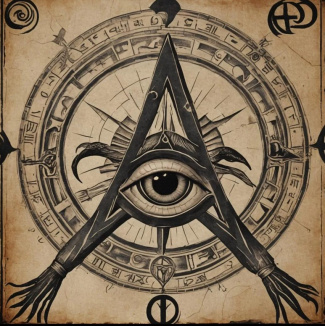Keepers of Harpocratis
In 1825 a group of young men were spurned from the rooms of the Hellsfire clubs, and founded a splinter group. The Order of Harpocratis epitomized the ideals of the leaders, founding their rituals on the ideal of Silence. In doing so they found a new path of magic revolving around sound and darkness. Their worship of Harpocratis, a bastardization of the worship of Horus from Egypt, found power and a paradigm that was difficult to master. Some of their teachings came down from early Roman texts that taught them paths known to a group known as the Ambulatis Niger. The unspoken learning by the Keepers is known as Discordia. They learn from a text known as The Principia Discordia. The Principia Discordia if read literally, encourages the worship of the Greek goddess Eris, known in Latin as Discordia, the goddess of disorder, or archetypes and ideals associated with her. Depending on the version of Discordianism, Eris might be considered the goddess exclusively of disorder or the goddess of disorder and chaos. Both views are supported by the Principia Discordia. The Principia Discordia holds three core principles: the Aneristic (order), the Eristic (disorder), and the notion that both are mere illusions. Due to these principles, a Discordian believes there is no distinction between order and disorder, since they are both man-made conceptual divisions of the pure element of chaos. An argument presented by the text is that it is only by rejecting these principles that you can truly perceive reality as it is, chaos.
The Principia Discordia holds three core principles: the Aneristic and Eristic principles representing order and disorder, and the notion that both are mere illusions. The following excerpt summarizes these principles:
The Aneristic Principle is that of apparent order; the Eristic Principle is that of apparent disorder. Both order and disorder are man made concepts and are artificial divisions of pure chaos, which is a level deeper than is the level of distinction making.
- With our concept-making apparatus called "the brain" we look at reality through the ideas-about-reality which our cultures give us. The ideas-about-reality are mistakenly labeled "reality" and unenlightened people are forever perplexed by the fact that other people, especially other cultures, see "reality" differently.
- It is only the ideas-about-reality which differ. Real (capital-T) True reality is a level deeper than is the level of concept. We look at the world through windows on which have been drawn grids (concepts). Different philosophies use different grids. A culture is a group of people with rather similar grids. Through a window we view chaos, and relate it to the points on our grid, and thereby understand it. The order is in the grid. That is the Aneristic Principle.
- Western philosophy is traditionally concerned with contrasting one grid with another grid, and amending grids in hopes of finding a perfect one that will account for all reality and will, hence, (say unenlightened westerners) be true. This is illusory; it is what we Erisians call the Aneristic Illusion. Some grids can be more useful than others, some more beautiful than others, some more pleasant than others, etc., but none can be more True than any other.
- Disorder is simply unrelated information viewed through some particular grid. But, like "relation", no-relation is a concept. Male, like female, is an idea about sex. To say that male-ness is "absence of female-ness", or vice versa, is a matter of definition and metaphysically arbitrary. The artificial concept of no-relation is the Eristic Principle.
- The belief that "order is true" and disorder is false or somehow wrong, is the Aneristic Illusion. To say the same of disorder, is the Eristic Illusion.
- The point is that (little-t) truth is a matter of definition relative to the grid one is using at the moment, and that (capital-T) Truth, metaphysical reality, is irrelevant to grids entirely. Pick a grid, and through it some chaos appears ordered and some appears disordered. Pick another grid, and the same chaos will appear differently ordered and disordered
Current membership includes:
- Marc Alex David: Deceased - April 1904
- Stacy Helmsworth: Deceased - June 1904
- Dand Vyacheslav Napoleoni
- Fredo Casimir Scarpa
- Ivan Ottomar Prosdocimi
- Gaétan Julius Daniau
- Weston Lenox Straub
- Marc Alex David: Deceased - April 1904
The lines of study explored by the Order of Harpocratis are:
- Fascination (Hedge Magic)
- Fortune (Hedge Magic)
- Hellfire (Hedge Magic)
- Shadowcasting (Hedge Magic)
- Sound Magic(Hedge Magic)
- Summoning, Binding & Warding (Hedge Magic)
Servants of Harpocratis
Ivan Prosdocimi found a ritual for summoning shadow demons, the Servants of Harpocratis. They are known as the Yamolg el Saag.
They evolve as times do, in 1900's they appear as shadow men wearing bowler hats. In night time settings with no unnatural light (like electric lights, gas lights, etc) their reddish eyes can be seen. They make virtually no sound, and do not talk.
They have a Strength of 5, a Dexterity of 4, Stamina of 5. Under bright lights all stats drop to 2. Loud noises can also harm them.

